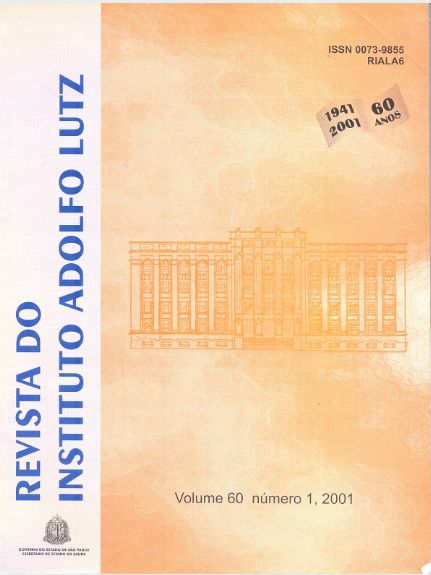Abstract
Cryptosporidium spp. has been described worldwide as an important causal agent of severe
and prolonged diarrhea, mainly in immunocompromised patients, particularly those with the acquired
immunodeficiency syndrome (AIDS). Outbreaks of cryptosporidiosis due to contaminated public water
supllies have been documented in the United States. Nevertheless, there are only a few reports about the role of food as a possible source of infection of cryptosporidiosis. The objective of the present study was
to detect the presence of oocysts of Cryptosporidium spp. in vegetables marketed in the city Ribeirão
Preto, Brazil. From July 1997 to June 1998, 198 vegetables collected in different commercial points of the
city were analysed in Adolfo Lutz Institute Ribeirão Preto. Oocysts of Cryptosporidium spp. were found
in two vegetables, one in arrugula and one in lettuce. We concluded that the parasitological methods used
can be useful in the detection of oocysts of Cryptosporidium spp. in vegetables and contribute to the
evaluation of the hygienic and sanitary conditions of vegetables.
References
1. Baraldi, S.R.; Marques, E.G.L.; Dias, R.M.D.S. Ocorrência de Cryptosporidum parvum e Isospora belli na região de Campinas, SP. Rev. Inst. Adolfo Lutz, 58(1): 97-103, 1999.
2. Brasil. Agência Nacional de Vigilância Sanitária. Resolução nº 12, Diário Oficial da União, Seção 1, p. 45, 10 de janeiro de 2001.
3. Brasil. Divisão Nacional de Vigilância Sanitária de Alimentos. Portaria nº 451, Diário Oficial da União, Seção 1, p. 4, 02 de julho de 1998.
4. Cordel, R.L.; Addis, D.G. Cryptosporidiosis in child care settings: A review of the literature and recommendations for prevention and control. Ped. Infect. Dis. J., 13: 210-217, 1994.
5. Fayer, R. et al. Cryptosporidium parvum in oysters from commercial harvesting sites in the Chesapeake Bay. Emerging Infect. Dis., 5(5): 706-710, 1999.
6. Fricker, C.R. e Crabb, J.H. Water-borne cryptosporidiosis: detection methods and treatment options. In: Baker, J.; Muller, R. e Rollinson, D. Opportunistic protozoa in humans. Advances Parasit., 40: 241-278, Academic Press, San Diego, 1998.
7. Griffiths, J.K. Human cryptosporidiosis: epidemiology, transmission, clinical disease, treatment and diagnosis. In: Baker, J.; Muller, R. e Rollinson, D. Opportunistic protozoa in humans. Advances Parasit., 40: 37-85, Academic Press, San Diego, 1998.
8. International Commission on Microbiological Specifications for Foods. Microorganisms in foods: their significance and methods o enumeration. University of Toronto, Toronto, 1978.
9. Käferstein, F.K. Food safety: a commonly underestimated public health issue. World Health Statistics Quaterly, 50: 3-4, 1997.
10. Laberge, I.; Griffiths, M.W. Prevalence, detection and control of Cryptosporidium parvum in food. Int. J. Food Microbiol., 31: 1 26, 1996.
11. Lennette, E.H. et al. Manual of Clinical Microbiology, 4th ed. Washington: American Society for Microbiology; 1985.
12. Ma, P. et al. Cryptosporidiosis in tourists returning from Caribbean. New England J. Med., 312: 647-648, 1985.
13. Mac Kenzie, W.R. et al. A massive outbreak in Milwaukee of Cryptosporidium infection transmitted through the public water supply. New England J. Med., 331: 161-167, 1994.
14. MacKenzie, W.R.; Kasmierezak, J.S.; Davis, J.P. An outbreak of cryptosporidiosis associated with a resort swimming pool. Epidemiol. Infec., 115: 545-553, 1995.
15. Mead, P.S. et al. Food-related illness and death in the United States. Emerging Infect. Dis., 5(5): 607-625, 1999.
16. Millard, P.S.; Gensheimer, K.F.; Addis, D.G. An outbreak of cryptosporidiosis from fresh-pressed apple cider. JAMA, 272: 1592 1596, 1994.
17. Petersen, C. Cryptosporidium and the food supply. Lancet, 345: 1128-1129, 1995.
18. Sauda, F.C. et al. Prevalence of Cryptosporidium sp and Isospora belli among AIDS patients attending Santos Reference Center for AIDS, São Paulo, Brazil. J. Parasit., 79(3): 454-456, 1993.
19. Takayanagui, O.M. et al. Fiscalização de hortas produtoras de verduras do município de Ribeirão Preto, SP. Rev. Soc. Bras. Med. trop., 33(2): 169-174, 2000.
20. Vanderzant, C.; Splittsoesser, D.F. Compendium of Methods for the Microbiological Examination of Foods, 3rd ed. American Public Health Association; 1992, 1100p.

This work is licensed under a Creative Commons Attribution 4.0 International License.
Copyright (c) 2001 Instituto Adolfo Lutz Journal
